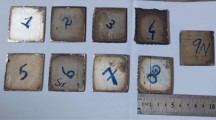Abstract
Plasma arc cutting (PAC) is a highly promising thermal cutting process because of its wide industrial applications involving cutting of different materials at high speeds. The competing abilities of PAC with laser cutting combined with its less polluting nature have shifted the research attention towards the process. The cutting parameters like arc current, torch stand-off, cutting speed and gas pressure play an important role in determining the quality of a cut surface. In the present work, the quality characteristics of the cut surface were assessed by measuring the surface roughness and kerf width while cutting the 304 L stainless steel. The experimental trials were designed by Taguchi’s L18 orthogonal array unlike the central composite design used with traditional response surface methodology (RSM), and an integrated approach of Grey Taguchi-based response surface methodology (GT-RSM) was disclosed for predicting the optimal combination of cutting parameters. The GT-RSM approach was found to improve the quality characteristics studied in the work significantly. The results will offer a good cutting database for the textile, chemical and pharmaceutical processing industries.
Similar content being viewed by others
References
Nemchinsky VA, Severance WS (2006) What we know and what we do not know about plasma arc cutting. J Phys D Appl Phys 39(22):423–438
Xu WJ, Fang JC, Lu YS (2002) Study of ceramic cutting by plasma arc. J Mater Process Technol 129(1):152–156
Pan W, Zhang W, Ma W, Wu C (2002) Characteristics of argon laminar DC plasma jet at atmospheric pressure. Plasma Chem Plasma Process 22(2):271–283
Harnicarova M, Zajac J, Stoic A (2010) Comparison of different material cutting technologies in terms of their impact on the cutting quality of structural steel. Tech Gaz 17(3):371–376
Harnicarova M, Valicek J, Cep R, Tozan H, Mullerova J, Grznárik R (2013) Comparison of non-traditional technologies for material cutting from the point of view of surface roughness. Int J Adv Manuf Technol 69(1–4):81–91
Ilii SM, Coteata M, Munteanu A (2010) Experimental results concerning the variation of surface roughness parameter (Ra) at plasma arc cutting of a stainless steel workpiece. Int J Mod Manuf Technol II/1:31–36
Salonitis K, Vatousianos S (2012) Experimental investigation of the plasma arc cutting process. Procedia CIRP 3:287–292
Bini R, Colosimo BM, Kutlu AE, Monno M (2008) Experimental study of the features of the kerf generated by a 200A high tolerance plasma arc cutting system. J Mater Process Technol 196(1–3):345–355
Ramakrishnan S, Gershenzon M, Polivka F, Kearney TN, Rogozinski MW (1997) Plasma generation for the plasma cutting process. IEEE Trans Plasma Sci 25(5):937–946
Nemchinsky VA, Severance WS (2009) Plasma arc cutting: speed and cut quality. J Phys D Appl Phys 42(19):195–204
Xu WJ, Fang JC, Lu YS (2002) Study of ceramic cutting by plasma arc. J Mater Process Technol 129(1–3):152–156
Gariboldi E, Previtali B (2005) High tolerance plasma arc cutting of commercially pure titanium. J Mater Process Technol 160(1):77–89
Wang J, Zhu Z, He C, Yang F (2011) Effect of dual swirling plasma arc cutting parameters on kerf characteristics. Int J Mater Form 4(1):39–43
Lermen RT, Machado IG (2012) Development of a new hybrid plasma torch for materials processing. J Mater Process Technol 212(11):2371–2379
Krishnaiah K, Shahabudeen P (2012) Applied design of experiments and Taguchi methods. PHI Learning Pvt Ltd., New Delhi
Hsiao YF, Tarng YS, Huang WJ (2007) Optimization of plasma arc welding parameters by using the Taguchi method with the grey relational analysis. Mater Manuf Process 23(1):51–58
Tosun N (2006) Determination of optimum parameters for multi-performance characteristics in drilling by using grey relational analysis. Int J Adv Manuf Technol 28(5–6):450–455
Ozek C, Caydas U, Unal E (2012) A fuzzy model for predicting surface roughness in plasma arc cutting of AISI 4140 steel. Mater Manuf Process 27(1):95–102
Yung KC, Liem H, Choy HS, Zheng HF, Yue TM (2010) Multiresponse optimization of surface plasma treatment using Taguchi method. Mater Manuf Process 25(9):1001–1011
Adalarasan R, Santhanakumar M, Shanmugasundaram A, Rajmohan M (2013) Optimization of weld characteristics of friction welded Al/SiCp composites using grey relational analysis and principal component analysis. Wulfenia J 20(1):422–433
Gopalakannan S, Senthilvelan T (2013) Application of response surface method on machining of Al–SiC nano-composites. Measurement 46:2705–2715
Mukherjee I, Ray PK (2006) A review of optimization techniques in metal cutting processes. Comput Ind Eng 50:15–34
Siddiquee AN, Khan ZA, Mallick Z (2010) Grey relational analysis coupled with principal component analysis for optimization design of the process parameters in in-feed centre less cylindrical grinding. Int J Adv Manuf Technol 46(9–12):983–992
Adalarasan R, Santhanakumar M, Shanmugasundaram A (2014) Optimization of weld characteristics of friction welded AA 6061-AA 6351 joints using grey-principal component analysis (G-PCA). J Mech Sci Technol 28(1):301–307
Author information
Authors and Affiliations
Corresponding author
Rights and permissions
About this article
Cite this article
Adalarasan, R., Santhanakumar, M. & Rajmohan, M. Application of Grey Taguchi-based response surface methodology (GT-RSM) for optimizing the plasma arc cutting parameters of 304L stainless steel. Int J Adv Manuf Technol 78, 1161–1170 (2015). https://doi.org/10.1007/s00170-014-6744-0
Received:
Accepted:
Published:
Issue Date:
DOI: https://doi.org/10.1007/s00170-014-6744-0




